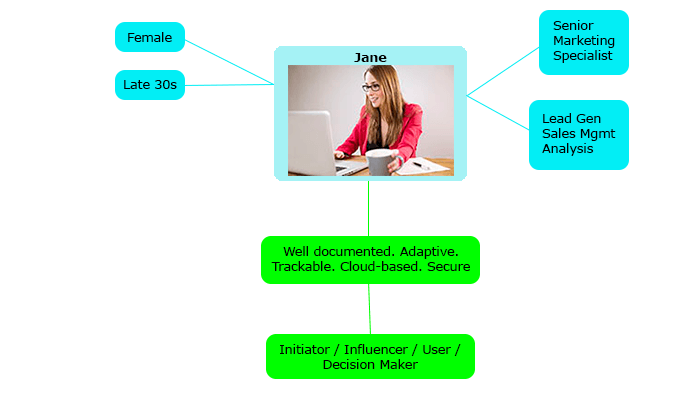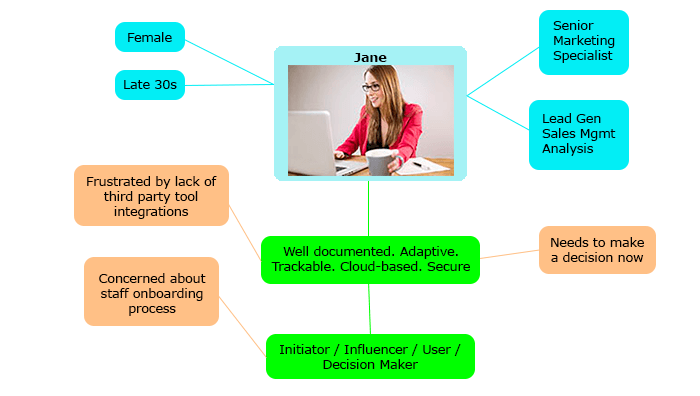Knowing how to create and use buyer persona (BP) is a quintessential marketing skill. Here in this article you’ll get some practical advice and tips on how to create buyer persona for your website.
Know your enemy, they say. But it’s even more important to know your friends. And in marketing, your best friends are customers. I’ve already mentioned the term “buyer persona” in one of my previous articles “How to Write a Creative Brief for a Website“, but today we’re going to study it up-close and personal.
Most marketers would define buyer persona as some fictional character, which represents an “ideal customer.” When creating buyer personas, marketing specialists usually base their assumptions on the analysis of the current clients’ behavior as well as the data on the age, psychology, motivation, and needs of the potential clients.
Buyer persona has a deep meaning: it brings your marketing strategy to life, because in business it’s all about the customers and their needs.
It doesn’t really matter, if you’re a B2B, B2C or a non-profit organization. What matters though is that a buyer persona makes your marketing activities meaningful and effective.
Not sure yet? Here are 10 indisputable arguments, proving that you won’t go far without buyer personas.

1. BP Is the Basis of Every Stage of Inbound Marketing
As a business owner or a marketing specialist, you probably know that luring some random visitors onto your website is not enough. You’ve got to have the right (target) visitors.
Buyer persona is your potential client. That’s whom you want to please and make a deal with. After all, your website, along with your glorious content and call-to-actions, were initially created to satisfy customer needs, weren’t they?
2. BP Can Improve the Quality of Leads
Knowing what your customers want, what their favorite content is and where they search for it helps you come up with just the right marketing tools. Use the information about your target audience to build an effective email marketing strategy and create lead campaigns, targeted for various groups of customers.
Better quality leads can lead you (no pun intended) to a better conversion, allowing you to adjust your marketing activities quickly and stay on top of the game.
3. BP Help Prioritize Marketing Efforts
If your marketing department is well aware of their buyer persona, it brings their thinking up to a whole different level. They understand who is their ideal customer and what he or she is like. What’s more, it helps you prioritize your efforts, fully concentrating on those customers who match your buyer persona.
4. BP Gives You the Information on Your Clients’ Whereabouts Online
Buyer persona is there to help you understand your customers a little better – find out about their interests, concerns, and where they like to spend their time on the Internet.
This data will guide your marketing activities into the right direction, where they are most likely to be noticed by your potential clients. There’s no point in creating a poll on Facebook when your target audience uses LinkedIn.
5. BP Guides Your Business Development
If you’re 100% sure about your customer needs, then you’ll be able to create a product or a service which satisfies these needs to their max and make people want to pay for it.
When this happens, customers feel that you’re the real thing and are more loyal to you.
6. BP Helps Create the Right Content
Inbound marketing is effective only in case if you put out the right content, which brings value to your potential clients.
The better you understand your customer, the easier it is for you to create effective content with potential to convert visitors into paid customers.

7. BP Helps Formulate the Strategy
After you’re done creating your buyer persona and realizing its strategic importance, make sure everyone else in the team understands it too.
When all members of your team understand the importance of buyer personas, it guides your business into the right direction and makes it easier to reach the strategic goals.
8. BP Earns You Customers’ Trust
If you always keep your buyer persona in mind while creating content, it definitely makes you a client-oriented business. True enough, this is the best way to show your customers that you care.
Of course, not all of your visitors are ready to make a purchase from the first sight, but this kind of approach will leave them genuinely interested and loyal to your brand. Sooner or later, when the need arises, be sure they’ll come back to you to spend some money.
9. BP Help Globalize Your Marketing Efforts
The Internet helped all major brands go global, but at the same time, it produced new challenges, because customers are not the same around the world.
Whenever you’re about to create a buyer persona for a certain regional market, make sure you’ve considered the cultural differences. This will help you earn your customers’ trust and make your sales and customer support teams work smoothly.

10. BP Is What Puts You Above Your Competition
Besides everything that’s been listed above, having and using buyer personas in your everyday business makes you stand out from the crowd. While your competitors SAY that they care, you actually SHOW customers that you care, and that’s something, if not everything.
Creating buyer personas can be tough even for seasoned marketers – it often shows how little they know about their audience. If you feel the same way too, don’t worry – it can’t be that bad. This article will give you all information you need to know about buyer personas along with some practical tips.
Let’s go!
The Beginning: Defining Your Buyer Persona
Everything starts from collecting the data about your clients. “How do I approach this?” you may ask. Well, start by choosing the parameters that you feel are important, such as:
- gender;
- age;
- occupation;
- job duties.
Most of this information can often be lifted from your CRM (date of birth, place of residence etc.). Bringing in some human aspect to your buyer persona may also help – why not give it a name and an avatar? This will lighten it up a little bit and bring some emotions in – it’s a human person after all.
Here’s an example for ya. Let’s talk about a buyer persona named “Jane.” She is a senior marketing specialist aged 30 something. Her job is to generate leads, find new and effective lead-generating tools. She also has a few sub-tasks, such as sales management and the analysis of competition. She also does marketing campaigns, creates marketing plans and strategies. Jane uses the data she collects to increase brand loyalty.
Due to the rapid growth of social networks, Jane is looking for a way to reach for their audience. Her number one priority is increasing brand recognition and loyalty without damaging the reputation of the brand. She’s into the automatic web development tools market and wants to make the right decisions quickly.
Based on what’s been said above, the buyer persona of Jane on this stage is going look something like this:

Now we’ve got our starting point. Next up are Jane’s needs, i.e. what she’s interested in and why. It takes a thorough research to find out what’s going in the mind of a customer. If we were talking about a traditional customer (as in the shop), we would say that she’s in the stage of “comparing the options.” She needs to make a decision soon and she’s looking for the best solutions, which are guaranteed to satisfy her needs. And maybe give her a little bit more!
Understanding the Customer Needs
More often than not customers themselves like to go on about what they need and how it should work for them, based on their current perspective. And that’s a very important thing.
Customers are most likely to follow the common tried-and-true pattern rather than risk getting into something new. All you have to do is ask them about it. However, the typical questions you use to generate leads wouldn’t work here. What would work though is simple polls, as they can really provide a great insight into the customer’s state of mind. Does your customer have an urgent need? Is he/she really interested in your product or just curious? Does he/she understand it? Even if you don’t know for sure what you customers want, you still can formulate some of their needs and apply them to Jane.
What kind of solution do people (who are in the same position as Jane) usually expect?
First of all, they most definitely need a simple product with sufficient documentation. Jane manages tens or even hundreds of employees, some of which may be more technical-savvy, than she is. It’ll take little time for these people to familiarize themselves with your product, but it may take a while for the others. You also want to add this persona’s needs and role in decision-making process. One persona can have several roles simultaneously – e.g. be an administrator and user.

Your product has to be adaptive enough to fit the platform and tools currently used by the customer’s company. The company may also have its own requirements to the products used, which you should consider: cloud-based access, custom security protocols etc. All these factors can contribute greatly to the customer’s decision-making process.
Certainly, such decisions are usually made jointly a group of people, but that’s not really important. Try to focus on just one persona and please don’t attempt at messing with the collective mind and decision-making process of group.
Common Objections
Just like any other map, our map has borders with checkpoints, which are there to prevent customers from going the wrong way. A lot of customers have their own experience, which consists of past and current successes and failures. You can have a joint conversation to discuss these checkpoints and put them on the map. This will give you a good perspective and help to see the potential issues before they even become such.
You should also define the customer’s place on the decision-making scale. Will he use your product right away? Or will he influence some other person, who is actually responsible for the decision-making? Or is it a combination of both? Find out where your persona is on the decision-making scale and what possible objections you may get.
Getting back to Jane, we’ll get something like this:

The final stage of creating buyer persona will have you filling in the data on the following characteristics:
- needs;
- worries;
- frustrations;
- urgency (of a purchase);
- place in the purchase cycle;
- requirements.
All types of marketing-related information should be based on the objections, worries and frustrations, yet concentrated on the needs, requirements and urgency. This way we will learn not only about the basic “age/gender/occupation” information, but also about some specific triggers that make our clients perform certain actions.
Try to remember the last time your own company made a significant purchase. I bet it was a long and arduous process, filled with bureaucracy. That’s something you also want to consider when creating a buyer persona.
Perfecting Your Buyer Personas
As soon as you’re done creating your buyer persona, share your results with the rest of the team to get some feedback. Ideally, you should revise your buyer persona every 90 days.
So, once you have your buyer persona in front of you, start taking actions – edit the content of your website/blog, based on the information you’ve learned about your potential customers. Make sure that the content is relevant to your buyer persona and resonates with the target audience. Don’t stop improving and perfecting your presence whenever possible, based on the feedback you get on the socials networks or in the comments.
Use lead generation forms to collect feedback from your visitors and analyze this data to see if it matches your buyer persona. For example, if your B2B clients differ by the size of the their company, be sure to include the appropriate question in the form.
The more precise information you get, the better your buyer persona would be. Still, try not to ask too many questions; otherwise, you’ll inevitably see a sharp drop in the conversion rate.
You don’t have to create a buyer persona for every type of customer that you get, because there are just too many of them. As always, use the common sense and try to identify the ones you want to target first.
And one last thing – keep in mind that customers are people after all, not subjects. They may act irrationally, make weird unmotivated decisions, but that’s what makes us people, isn’t it? In this case, the journey is just as important as the destination – the smoother it goes, the more your customer is likely to pay you.
The right thing to do would be share this article with your friends on the social networks – just click on one of the icons of social media, it’s that easy.
If you have further questions on the subject, please write them in comments – I’ll be glad to answer.





Comments0